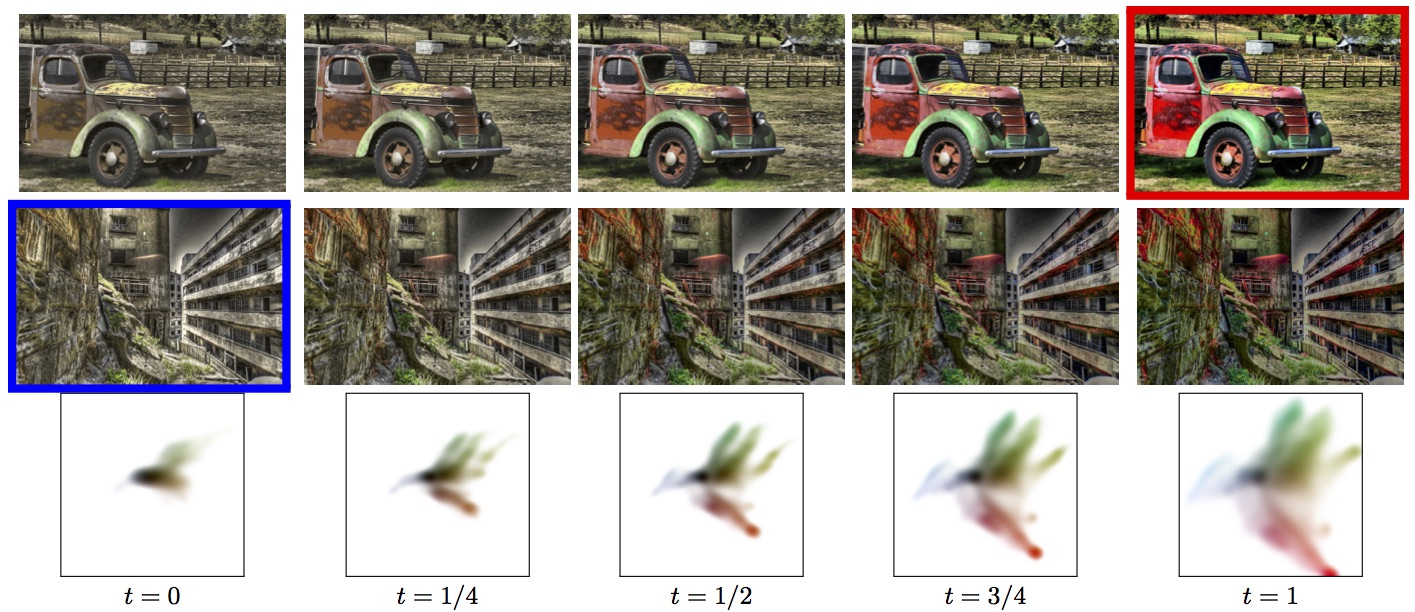Section: Overall Objectives
Static Optimal Transport and Generalizations
Optimal Transport, Old and New.
Optimal Mass Transportation is a mathematical research topic which started two centuries ago with Monge's work on the “Théorie des déblais et des remblais" (see [103]). This engineering problem consists in minimizing the transport cost between two given mass densities. In the 40's, Kantorovich [110] introduced a powerful linear relaxation and introduced its dual formulation. The Monge-Kantorovich problem became a specialized research topic in optimization and Kantorovich obtained the 1975 Nobel prize in economics for his contributions to resource allocations problems. Since the seminal discoveries of Brenier in the 90's [56], Optimal Transportation has received renewed attention from mathematical analysts and the Fields Medal awarded in 2010 to C. Villani, who gave important contributions to Optimal Transportation and wrote the modern reference monographs [150], [149], arrived at a culminating moment for this theory. Optimal Mass Transportation is today a mature area of mathematical analysis with a constantly growing range of applications. Optimal Transportation has also received a lot of attention from probabilists (see for instance the recent survey [120] for an overview of the Schrödinger problem which is a stochastic variant of the Benamou-Brenier dynamical formulation of optimal transport). The development of numerical methods for Optimal Transportation and Optimal Transportation related problems is a difficult topic and comparatively underdeveloped. This research field has experienced a surge of activity in the last five years, with important contributions of the Mokaplan group (see the list of important publications of the team). We describe below a few of recent and less recent Optimal Transportation concepts and methods which are connected to the future activities of Mokaplan :
Brenier's theorem [57] characterizes the unique optimal map as the gradient of a convex potential. As such Optimal Transportation may be interpreted as an infinite dimensional optimisation problem under “convexity constraint": i.e. the solution of this infinite dimensional optimisation problem is a convex potential. This connects Optimal Transportation to “convexity constrained" non-linear variational problems such as, for instance, Newton's problem of the body of minimal resistance. The value function of the optimal transport problem is also known to define a distance between source and target densities called the Wasserstein distance which plays a key role in many applications such as image processing.
Monge-Ampère Methods.
A formal substitution of the optimal transport map as the gradient of a convex potential in the mass conservation constraint (a Jacobian equation) gives a non-linear Monge-Ampère equation. Caffarelli [65] used this result to extend the regularity theory for the Monge-Ampère equation. In the last ten years, it also motivated new research on numerical solvers for non-linear degenerate Elliptic equations [91] [118] [42] [43] and the references therein. Geometric approaches based on Laguerre diagrams and discrete data [127] have also been developed. Monge-Ampère based Optimal Transportation solvers have recently given the first linear cost computations of Optimal Transportation (smooth) maps.
Generalizations of OT.
In recent years, the classical Optimal Transportation problem has been extended in several directions. First, different ground costs measuring the “physical" displacement have been considered. In particular, well posedness for a large class of convex and concave costs has been established by McCann and Gangbo [102]. Optimal Transportation techniques have been applied for example to a Coulomb ground cost in Quantum chemistry in relation with Density Functional theory [87]. Given the densities of electrons Optimal Transportation models the potential energy and their relative positions. For more than more than 2 electrons (and therefore more than 2 densities) the natural extension of Optimal Transportation is the so called Multi-marginal Optimal Transport (see [131] and the references therein). Another instance of multi-marginal Optimal Transportation arises in the so-called Wasserstein barycenter problem between an arbitrary number of densities [27]. An interesting overview of this emerging new field of optimal transport and its applications can be found in the recent survey of Ghoussoub and Pass [130].
|
Numerical Applications of Optimal Transportation.
Optimal transport has found many applications, starting from its relation with several physical models such as the semi-geostrophic equations in meteorology [107], [89], [88], [36], [117], mesh adaptation [116], the reconstruction of the early mass distribution of the Universe [99], [58] in Astrophysics, and the numerical optimisation of reflectors following the Optimal Transportation interpretation of Oliker [66] and Wang [151]. Extensions of OT such as multi-marginal transport has potential applications in Density Functional Theory , Generalized solution of Euler equations [55] (DFT) and in statistics and finance [33], [101] .... Recently, there has been a spread of interest in applications of OT methods in imaging sciences [50], statistics [47] and machine learning [90]. This is largely due to the emergence of fast numerical schemes to approximate the transportation distance and its generalizations, see for instance [39]. Figure 1 shows an example of application of OT to color transfer. Figure 9 shows an example of application in computer graphics to interpolate between input shapes.



